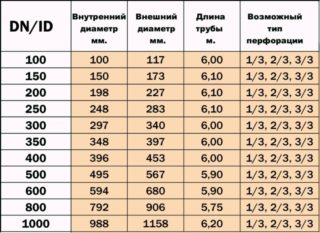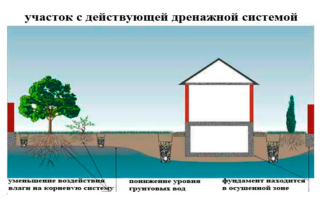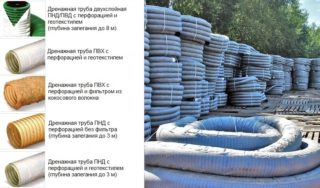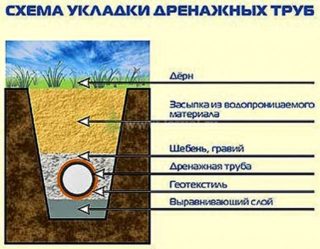Areas with a large amount of groundwater must be drained. For this purpose, a special drainage system is installed. Its design includes perforated sleeves and polymer wells: inspection, storage, rotary, filtering. The entire system is mounted on a slope for better water flow. In private ownership, pipes with a cross section of 11 cm are mainly used.This diameter is most optimal for the average monthly volume of wastewater. Prices for drainage pipes 110 mm in a geotextile filter depend on the manufacturer and the inner section of the hose.
Application area
- removal of moisture from the roadway in order to prevent its subsidence;
- high-quality drainage of soil around buildings: cottages, log cabins, other private / public houses;
- preparation of the soil for further productive planting of fruit or vegetable crops;
- drainage of sports grounds;
- diversion of water from flooded / waterlogged pastures and other agricultural land.
Such pipes are more often used on loamy, clayey and sandy soils of medium and high moisture content.
Types of pipes in geotextile
- polymer sleeve;
- outer shell made of geotextile;
- special couplings for laying an extended system.
Drain pipes in the filter are classified by strength and density:
- Single layer. It looks like a regular corrugated sleeve. Stiffening ribs of the product allow it to be laid to a depth of 4.5-5 meters. The upper layer is filter geotextile.
- Two-layer. Includes a first layer in the form of a corrugation and an inner layer in the form of a smooth sleeve. Due to this, from the inside, the walls of the drainage pipe remain smooth and do not contribute to the settling of sludge on them. And the sleeve itself can be laid at an angle without fear of damaging the corrugation.
Drains are made from the following polymers:
- Polyvinyl chloride. The material is distinguished by its absolute inertness to aggressive media. It is resistant to temperature extremes and does not change its structure even in severe frosts. However, you should be careful with the pipes when laying the system in the cold. At subzero temperatures, polyvinyl chloride becomes brittle and any mechanical impact on it can deform the product. The weight of the PVC pipe is insignificant, which allows the owner of the site to independently lay the system. With linear expansion, the material is highly plastic. The PVC corrugated sleeve can be laid at a 90 degree angle without the risk of damaging its outer side.
- Polypropylene. Resistant to frost and more flexible. Able to freeze and defrost without losing its elasticity. Polypropylene pipes are in great demand in regions with cold climates.
- Polyethylene. No less plastic, lightweight and at the same time a cheap type of polymer. The polyethylene sleeves can be laid up to a depth of 3 meters.
The type of pipe and its section are selected depending on the climatic conditions in the region and the monthly volume of groundwater at the site.
Drainage pipe dimensions

Pipes in a geotextile filter are sold in linear meters. One roll 40-50 m. The buyer has the opportunity to purchase the length of the sleeve required for the installation of the system without using additional connections. There are drains according to the size of the internal section:
- 63 mm - designed for small garden areas with a small amount of groundwater;
- 90 mm - used in private premises to drain moisture from the foundation of the building;
- 110 mm - ideal for installing a drainage system in areas up to 200 m2;
- 160 mm - the most suitable for the installation of a drainage structure on a site with an area of more than 200 m2;
- 200 mm is a good option for sloping terrain, especially if its decrease is observed from a hill towards a given object.
The geotextile filter prevents fine debris - sand, earth from seeping into the drains. On insufficiently smooth surfaces of the sleeves, they can provoke silting. As a result, the system can become seriously clogged over time.
Advantages and disadvantages
The important advantages of drainage pipes in the filter are:
- Excellent durability of products. The stiffness of the corrugation rings (stiffeners) is 4 kN / m2. This allows it to withstand a serious load even on moving ground.
- Long service life. Compared to ceramic or concrete pipes, polymer products last from 70 years or more.
- Low weight of products. Even one master can handle them without the involvement of special equipment. In addition, such drains can be transported by light transport.
- High resistance to temperature extremes. Polymer drainage hoses can be used in the range of -40 - +90 degrees. And they will not change their original properties.
- Maximum smooth inner surface of pipes. Thanks to this, the sliding of water passes easier, debris on the walls of the system does not linger.
- The presence of a geotextile filter that does not allow small debris to penetrate into the drainage collector.
- Acceptable cost - saving the family budget for the installation of a drainage system.
The disadvantages of polymer pipes in geotextiles include the thickness of the filter. It is only 1.7 mm. When installing the system, you should be extremely careful not to damage the filter layer. Otherwise, you will have to change the drain section and use additional connections / couplings.
Features of installation and laying
- The width of the trench should exceed the section of the sleeve by 40-50 cm. The spare space is later used for fixing sprinkling. Accordingly, for a pipe with a cross section of 110 mm, the width of the trench should be about 50-60 cm.
- A cushion of coarse sand or fine grained rubble is poured into the prepared ditches. At this stage, the slope of the plane for the system is formed at the rate of 5-7 mm for each meter of the length of the pipeline. The pillow is carefully tamped.
- All sleeves are laid on the finished base. Joints, if necessary, are connected with fittings. To do this, use couplings for a straight manifold, tees or crosses for branching, swivel fittings when changing the trajectory of the system.
- The finished structure is covered from all sides with a mixture of sand and gravel. In this case, you do not need to ram.
- The upper part of the trenches is covered with soil with a protrusion above the surface of the site. This is necessary in order for the embankment to settle down by itself under the influence of precipitation.
Under no circumstances should the upper layers of the backfill be rammed. The risk of damaging pipes in the ground is too high.
When carrying out work, it is advisable to avoid dragging the sleeve along the ground. Careless handling of drains can damage the thin layer of the filter, which will require unnecessary financial costs in the future.
Prices for pipes in a geotextile filter
The cost of drainage hoses depends on its internal section and manufacturer. Roughly prices are as follows:
| Manufacturer | Internal section of the pipe (mm) | Price (rub / m. Running) |
| Sibur | 63 mm | RUB 47 |
| Sibur | 110 mm | RUB 60 |
| Sibur | 160 mm | RUB 115 |
| Sibur | 200 mm | 195 RUB |
| Typar | 63 mm | 51 rbl. |
| Typar | 110 mm | RUB 70 |
| Typar | 160 mm | RUB 125 |
| Typar | 200 mm | 210 RUB |
All drainage pipes with a section of 200 mm are sold in rolls of 40 m each. Double-layer sleeves have corresponding prices:
- 110 mm - 145 rubles / running meter;
- 160 mm - 240 rubles / running meter;
- 200 mm - 370 rubles / meter.
When buying drainage pipes in geotextiles, immediately purchase the required number of couplings. You can find out the required number of elements from the project documentation / drawing.











